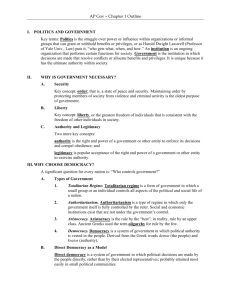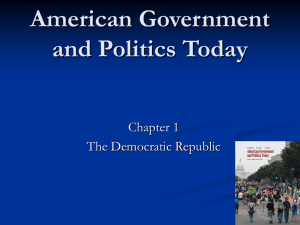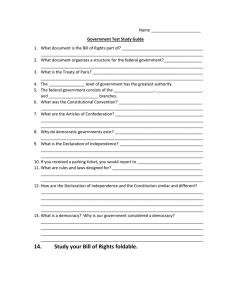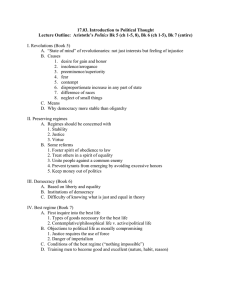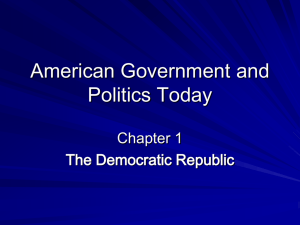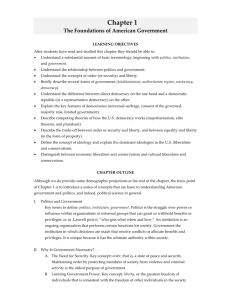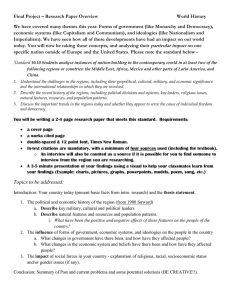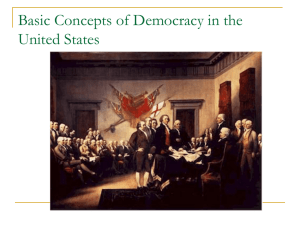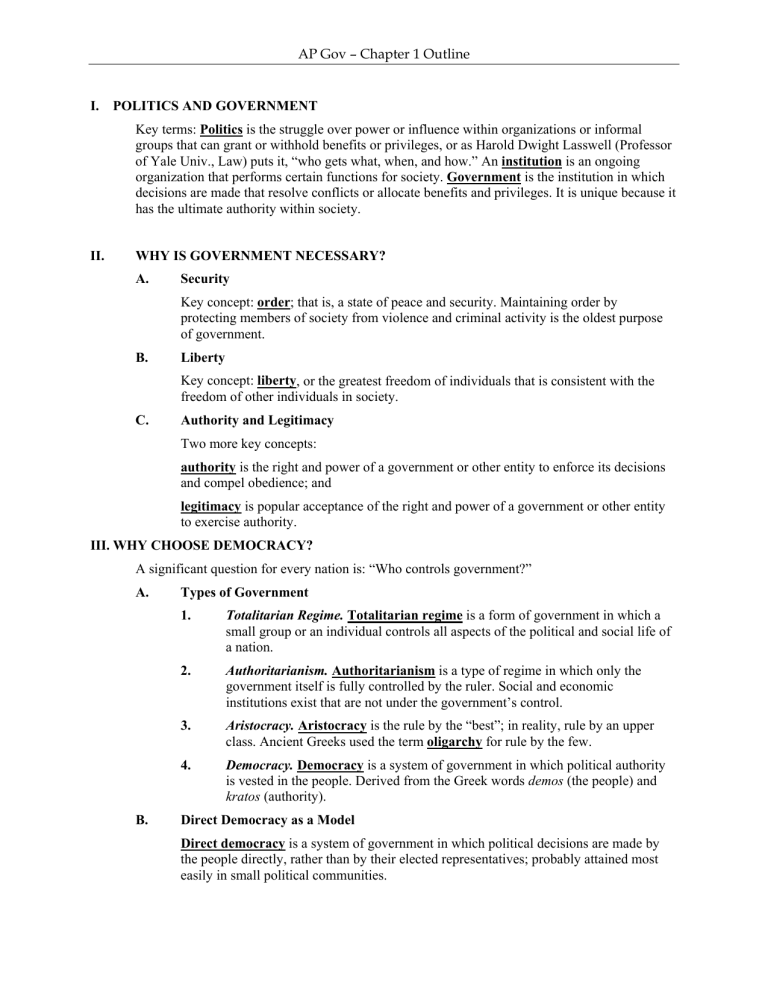
AP Gov – Chapter 1 Outline I. POLITICS AND GOVERNMENT Key terms: Politics is the struggle over power or influence within organizations or informal groups that can grant or withhold benefits or privileges, or as Harold Dwight Lasswell (Professor of Yale Univ., Law) puts it, “who gets what, when, and how.” An institution is an ongoing organization that performs certain functions for society. Government is the institution in which decisions are made that resolve conflicts or allocate benefits and privileges. It is unique because it has the ultimate authority within society. II. WHY IS GOVERNMENT NECESSARY? A. Security Key concept: order; that is, a state of peace and security. Maintaining order by protecting members of society from violence and criminal activity is the oldest purpose of government. B. Liberty Key concept: liberty, or the greatest freedom of individuals that is consistent with the freedom of other individuals in society. C. Authority and Legitimacy Two more key concepts: authority is the right and power of a government or other entity to enforce its decisions and compel obedience; and legitimacy is popular acceptance of the right and power of a government or other entity to exercise authority. III. WHY CHOOSE DEMOCRACY? A significant question for every nation is: “Who controls government?” A. B. Types of Government 1. Totalitarian Regime. Totalitarian regime is a form of government in which a small group or an individual controls all aspects of the political and social life of a nation. 2. Authoritarianism. Authoritarianism is a type of regime in which only the government itself is fully controlled by the ruler. Social and economic institutions exist that are not under the government’s control. 3. Aristocracy. Aristocracy is the rule by the “best”; in reality, rule by an upper class. Ancient Greeks used the term oligarchy for rule by the few. 4. Democracy. Democracy is a system of government in which political authority is vested in the people. Derived from the Greek words demos (the people) and kratos (authority). Direct Democracy as a Model Direct democracy is a system of government in which political decisions are made by the people directly, rather than by their elected representatives; probably attained most easily in small political communities. AP Gov – Chapter 1 Outline C. 1. Direct Democracy Today. Key concepts are the initiative, a procedure by which voters can propose a law or a constitutional amendment; the referendum, an electoral device whereby legislative or constitutional measures are referred by the legislature to the voters for approval or disapproval; and the recall, a procedure allowing the people to vote to dismiss an elected official from state office before his or her term has expired. 2. Teledemocracy. Will the Internet really have any impact on our democratic system? Because of the Internet, Americans have more access to political information than ever before. Further, they can contact their elected representatives, form political interest groups, and even vote online. The Obama campaign in 2008 pioneered the use of the Internet to build a fundraising base and communicate regularly with supporters. The Dangers of Direct Democracy Although the founders believed in government based on the consent of the people, they were highly distrustful of anything that might look like “mob rule.” They, therefore, devised institutions to filter the popular will through elected elites. D. A Democratic Republic The terms republic and democratic republic are key, as is the term representative democracy. The differences between these terms are subtle. By itself, a republic can have many undemocratic features. Democratic republic and representative democracy really mean the same thing—government based on elected representatives. 1. Principles of Democratic Government. These include universal suffrage, the right of all adults to vote for their representatives, and majority rule, which means that the greatest number of citizens in any political unit should select the officials and determine policies. 2. Constitutional Democracy. The key concept is limited government, the principle that the powers of government should be limited, usually by institutional checks. Without such limits, democracy could destroy itself. IV. WHO REALLY RULES IN AMERICA? The text discusses three theories about how American democracy could work. A. Majoritarianism Majoritarianism is a political theory holding that in a democracy, the government ought to do what the majority of the people want. Popular as a principal, but determining what constitutes a majority can be difficult in practice. B. Elitism Elite theory assumes the population has little impact on the decision-making process. Ultimately, policy decisions are made by a select few within the society. These elites share a goal of governmental stability because they do not want their position within society jeopardized. Studies of elite opinion, however, suggest that elites are more tolerant of diversity, more willing to defend individual liberties, and more supportive of democratic values than are members of the mass public. C. Pluralism AP Gov – Chapter 1 Outline Pluralism is a theory assumes that our form of democracy is based on group interests. Groups, or factions, work to promote their interests and through a series of compromises, public policy decisions are made. V. FUNDAMENTAL VALUES The founders believed that the structures and processes of governing would be sustained by a supportive political culture—the set of ideas, values, and ways of thinking about government and politics that are shared by all citizens. The process of political socialization ensures that successive generations of Americans adopt these values. A. Individual Freedom Most of the explicitly guaranteed liberties appear in the Bill of Rights, or the first ten amendments to the Constitution. These rights are not absolute and may be curtailed during wartime or when rights conflict with one another. An example of this conflict is liberty versus security. B. Equality There are many kinds of equality, some of which are more controversial than others. Equality under the law regardless of race, religion, or gender is a popular value today, but was not accepted as a norm even fifty years ago. Equality of opportunity is a concept with much support. Economic equality is more controversial because to pursue this goal would require a redistribution of wealth from rich to poor. Regardless, the notion of egalitarianism is quite prevalent in U.S. anti-poverty policies. C. Order A primary function of government is to promote stability and order in daily life. Although citizens expect to be free of chaos, the values of liberty, equality, and order are often in tension with one another. D. Property Economic equality fairness as a value comes into conflict with property rights and with the capitalist system in general. Key concepts: Capitalism, an economic system characterized by the private ownership of wealthcreating assets and also by free markets and freedom of contract. The U.S. Supreme Court made a significant ruling in this area in Kelo v. New London, upholding the ability of a local government to use its power of eminent domain to take private property in order to turn it over to private developers so that an office park and condominiums could be built. VI. POLITICAL IDEOLOGIES A traditional method of comparing ideologies is to array them on a continuum from left to right, based primarily on the large or small role for government. See Table 1-1 in the text. A. The Traditional Political Spectrum 1. Socialism. Socialism is a political ideology based on strong support for economic and social equality, falls on the left side of the spectrum. Socialists AP Gov – Chapter 1 Outline traditionally envisioned a society in which major businesses were taken over by the government or by employee cooperatives. 2. B. C. Libertarianism. This is a political ideology based on skepticism or opposition toward almost all government activities, falls on the right side of the spectrum. In the Middle: Liberalism and Conservatism 1. Conservatism. This favors a limited role for government in helping individuals. Economic freedom is seen as a necessity for the good of the society. On social issues, conservatives advocate governmental involvement to preserve traditional values and lifestyles. 2. Liberalism. This favors governmental regulation of the economy to benefit individuals within the society. On social issues, liberals advocate a limited governmental role. Social freedom is seen as a necessity for the good of the society. The Difficulty Defining Liberalism and Conservatism The meanings of these terms, although ubiquitous in American politics, have evolved over time and may represent very different ideas depending on who is using the term. D. 1. Liberalism. The term liberal is often traced to philosophical liberalism, also called individualism, at the core of John Locke’s philosophy of government. In this sense preserving individual liberty and property rights is paramount among the reasons for having government. 2. Conservatism. In the past conservatism was linked to resistance to change; however, today the meaning is often two-fold. Economic conservatives differ from social conservatives. Economic conservatives believe in less government, support for capitalism and private property, and allowing individuals to pursue their own route to achievement with little government interference. Social conservatives support traditional social values, including opposition to abortion, support for the death penalty or the right to own firearms, and opposition to gay marriage. 3. Libertarianism. Libertarians believe that government should not regulate the economy and advocate almost complete freedom in social matters. They oppose government action to promote traditional moral values, although such action is often favored by other groups on the political right. Libertarians’ strong support for civil liberties seems to align them more closely with modern liberals than with conservatives. The Global Range of Ideologies Communism and fascism have few followers in the United States today; however, both ideologies influenced the development of Europe and Asia. E. Radical Islam The ideology embraced by al Qaeda and several other terrorist and political movements is based on a radical and fundamentalist interpretation of Islam, an interpretation sometimes called Islamism or Radical Islam. The goal of this ideology is to bring all Muslim peoples back to a form of government ruled by religious leaders according to the strict interpretation of the Koran. VII. THE CHALLENGE OF CHANGE AP Gov – Chapter 1 Outline In the next 50 years, the United States will face internal and external challenges. Not only will the face of America change as its citizens age, become more diverse, and generate new needs for laws and policies, but it will also have to contend with a lessening of its economic dominance in the world. A. Demographic Change in a Democratic Republic The proportion of Americans who are elderly is growing even as our fertility rate is leveling-off. B. Ethnic Change The Hispanic and Asian portions of the U.S. population are expected to increase in future generations. This is due not only to immigration but also to high fertility rates of new immigrant families after they settle in this country. Key term: Hispanic, someone who can claim a heritage from a Spanish-speaking country. Over half are Mexican Americans, a tenth are Puerto Ricans, and the rest come from a very wide range of countries. C. Globalization Globalization refers to the interconnection of markets and economies across the globe. This trend is challenging to all nations because no single nation can regulate global corporations. Globalization also changes employment patterns, shifting jobs from one nation to another. D. Environmental Change The great majority of scientists believe that global warming is taking place. There is pressure for the United States to enter treaties that limit carbon emissions, but this is controversial.
